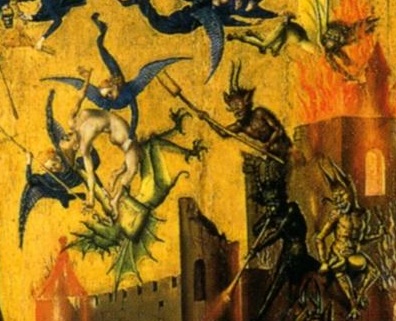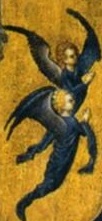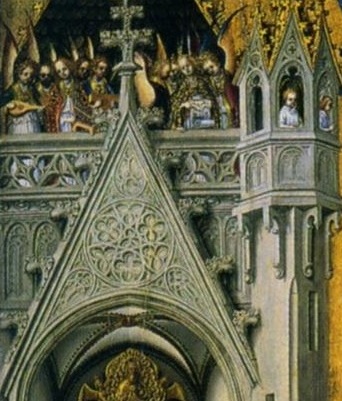Last Judgement (Lochner) on:
[Wikipedia]
[Google]
[Amazon]
''Last Judgement'' (German: ''Weltgericht'') is a c. 1435
 The painting is divided into an upper and lower register. The upper half is dominated by the three large forms of
The painting is divided into an upper and lower register. The upper half is dominated by the three large forms of
Last Judgement Lochner detail6.jpg, Angels hold the cross above Mary
Last Judgement Lochner detail5.jpg,
The lower half of the panel shows a large body of mortals and demons. The dead rise from their graves, and depending on the judgement of Christ, are either received into heaven or banished into hell. As is traditional, the saved are accompanied by angels as they move towards (from the viewer's perspective) the left hand side of the picture. The damned, who occupy two thirds of the lower half of the panel, are scuttled and tormented by demons towards the right hand side. In this work, the saved are finally greeted by
Last Judgement Lochner detail7.jpg, The gates of heaven
Last Judgement Lochner detail3.jpg, The dead rise from their graves
Last Judgement Lochner detail2.jpg, The damned dragged to hell by demons
Technical examination reveals numerous and detailed underdrawings, none of which deviate significantly from the final composition. Most of these sketches focus on the three saint's clothes, which are laid out using cross- Both its attribution and dating have proved difficult and it was long thought to be by a workshop member, pupil or follower of Lochner. The debate arose in particular because the panel is so different in composition and mood to other known works by Lochner, which in contrast to the dramatic visions contained in this panel, are known for their late Gothic serenity and soft colourisation.
Both its attribution and dating have proved difficult and it was long thought to be by a workshop member, pupil or follower of Lochner. The debate arose in particular because the panel is so different in composition and mood to other known works by Lochner, which in contrast to the dramatic visions contained in this panel, are known for their late Gothic serenity and soft colourisation.
 It is believed to originate from early in his career, as in places it does not, according to art critic Emmy Wellesz, "attain the perfect harmony of line, the subtle relationship of the component parts within the total structure, which we admire in Lochner's mature work". Mindful of similar differences, other art historians have argued that it should be placed at the end of his career, when he was trying to break from his usual conventions. Analysis of the patterns of the tree rings dates the earliest of its three boards to 1406, which accounting for seasoning and maturing gives an earliest date of completion of c 1425. However, it is considered one of the most important paintings in his oeuvre, critics cite its "dramatic excitement" and the study of
It is believed to originate from early in his career, as in places it does not, according to art critic Emmy Wellesz, "attain the perfect harmony of line, the subtle relationship of the component parts within the total structure, which we admire in Lochner's mature work". Mindful of similar differences, other art historians have argued that it should be placed at the end of his career, when he was trying to break from his usual conventions. Analysis of the patterns of the tree rings dates the earliest of its three boards to 1406, which accounting for seasoning and maturing gives an earliest date of completion of c 1425. However, it is considered one of the most important paintings in his oeuvre, critics cite its "dramatic excitement" and the study of
tempera
Tempera (), also known as egg tempera, is a permanent, fast-drying painting medium consisting of colored pigments mixed with a water-soluble binder medium, usually glutinous material such as egg yolk. Tempera also refers to the paintings done ...
on oak polyptych
A polyptych ( ; Greek: ''poly-'' "many" and ''ptychē'' "fold") is a painting (usually panel painting) which is divided into sections, or panels. Specifically, a "diptych" is a two-part work of art; a "triptych" is a three-part work; a tetrapty ...
by the German artist Stefan Lochner
Stefan Lochner (the ''Dombild Master'' or ''Master Stefan''; c. 1410 – late 1451) was a German painter working in the late International Gothic period. His paintings combine that era's tendency toward long flowing lines and brilliant colours ...
, probably commissioned for the council chamber of City Hall of Cologne
Cologne ( ; german: Köln ; ksh, Kölle ) is the largest city of the German western States of Germany, state of North Rhine-Westphalia (NRW) and the List of cities in Germany by population, fourth-most populous city of Germany with 1.1 m ...
, but now broken apart.Wellesz, 7 Today the outer wings, which formed a sixfold partition when extended, have been sawed off into twelve individual pictures,Chapuis, 263 most of which are still extant but held in separate collections,Wellesz, 4 mostly in Cologne, Munich and Frankfurt. The interior wings included the '' Martyrdom of the Apostles'', the exterior panels comprised in part of the ''Saint Anthony Abbot'', ''Mary Magdalene and a Donor'', ''Saints Catherine, Hubert, Quirinus of Neuss, and a Donor'', and ''Pope Cornelius''.Chapuis, 262 Its depiction of the Last Judgment
The Last Judgment, Final Judgment, Day of Reckoning, Day of Judgment, Judgment Day, Doomsday, Day of Resurrection or The Day of the Lord (; ar, یوم القيامة, translit=Yawm al-Qiyāmah or ar, یوم الدین, translit=Yawm ad-Dīn, ...
follows many of the conventions of contemporary doom paintings
A "Doom painting" or "Doom" is a traditional English term for a wall-painting of the Last Judgment in a medieval church. This is the moment in Christian eschatology when Christ judges souls to send them to either Heaven or Hell.
The subje ...
, but Lochner introduces important innovations, especially in his rendering of the angel's black and flowing clothes.
The panel is first recorded in 1764, in an inventory of the Parish Church of St Lawrence, Cologne, and is now in the Wallraf-Richartz-Museum, Cologne, since it was bequeathed in 1824.
Description
 The painting is divided into an upper and lower register. The upper half is dominated by the three large forms of
The painting is divided into an upper and lower register. The upper half is dominated by the three large forms of Jesus
Jesus, likely from he, יֵשׁוּעַ, translit=Yēšūaʿ, label=Hebrew/Aramaic ( AD 30 or 33), also referred to as Jesus Christ or Jesus of Nazareth (among other names and titles), was a first-century Jewish preacher and religious ...
, Mary
Mary may refer to:
People
* Mary (name), a feminine given name (includes a list of people with the name)
Religious contexts
* New Testament people named Mary, overview article linking to many of those below
* Mary, mother of Jesus, also calle ...
and St. John. Jesus is placed in the center of the upper half of the panel, sitting on a double rainbow which emits beams, with his hand held outwards. Mary and John kneel at either side of him in poses of prayer as they beg for salvation for the souls beneath.Chapuis, 41 Jesus' right hand is raised in the act of blessing the dead who are to be admitted to the Kingdom of Heaven, his left hand is lowered as he condemns the sinners to eternal punishment. He is dressed in a red robe decorated with pearls. His robe is open to reveal the nails holes in his hands and the wound to his lower chest sustained during his crucifixion
Crucifixion is a method of capital punishment in which the victim is tied or nailed to a large wooden cross or beam and left to hang until eventual death from exhaustion and asphyxiation. It was used as a punishment by the Persians, Carthagin ...
. Jesus looks down toward the saved to his right. A large group of angels hover at either side of him, some hold the arma Christi
Arma Christi ("weapons of Christ"), or the Instruments of the Passion, are the objects associated with the Passion of Jesus Christ in Christian symbolism and art. They are seen as arms in the sense of heraldry, and also as the weapons Christ ...
- the attributes of the Passion of Christ. The two angels by his feet play long trumpets, signaling judgement.Wellesz, 5
The saints domination of the panel is achieved both through their relative size compared to angels and the mortals below (as is usual for paintings of the "Last Judgement"), but also according to Weiss, through the "impact of their gestures and the massive curves of their garments". They are dressed in bright and vivid clothes, Jesus' robe is ruby red, St. John's is emerald, Mary's is amethyst
Amethyst is a violet variety of quartz. The name comes from the Koine Greek αμέθυστος ''amethystos'' from α- ''a-'', "not" and μεθύσκω (Ancient Greek) / μεθώ (Modern Greek), "intoxicate", a reference to the belief that t ...
coloured.
Christ in Majesty
Christ in Majesty or Christ in Glory ( la, Maiestas Domini) is the Western Christian image of Christ seated on a throne as ruler of the world, always seen frontally in the centre of the composition, and often flanked by other sacred figures, whos ...
File:Last Judgement Lochner detail8.jpg, St John kneels in prayer
St. Peter
) (Simeon, Simon)
, birth_date =
, birth_place = Bethsaida, Gaulanitis, Syria, Roman Empire
, death_date = Between AD 64–68
, death_place = probably Vatican Hill, Rome, Italia, Roman Empire
, parents = John (or Jonah; Jona)
, occupation ...
as they enter a heavenly city, while the lost are driven towards the blazing fires of hell
In religion and folklore, hell is a location in the afterlife in which evil souls are subjected to punitive suffering, most often through torture, as eternal punishment after death. Religions with a linear divine history often depict hell ...
. The faces and expressions of the damned are full of dread and physical pain. Some of the devils drag the condemned using a chain, in a passage in the lower right, four demons drag souls towards a pit where other devils wait at a raging fire. The demons gnash their teeth.
hatching
Hatching (french: hachure) is an artistic technique used to create tonal or shading effects by drawing (or painting or scribing) closely spaced parallel lines. (It is also used in monochromatic representations of heraldry to indicate what the ...
of various intensity. The faces of the saints are rarely described, with their eyes indicted merely by poorly defined circles. The painting is in poor condition, and has suffered heavy discoloration. The background was originally blue but is now black; its main pigment was azurite
Azurite is a soft, deep-blue copper mineral produced by weathering of copper ore deposits. During the early 19th century, it was also known as chessylite, after the Type locality (geology), type locality at Chessy, Rhône, Chessy-les-Mines near ...
, which over the centuries has darkened considerably. Some of the original patterns of the figures clothes are now barely discernible, but can be detected through x-ray.
 Both its attribution and dating have proved difficult and it was long thought to be by a workshop member, pupil or follower of Lochner. The debate arose in particular because the panel is so different in composition and mood to other known works by Lochner, which in contrast to the dramatic visions contained in this panel, are known for their late Gothic serenity and soft colourisation.
Both its attribution and dating have proved difficult and it was long thought to be by a workshop member, pupil or follower of Lochner. The debate arose in particular because the panel is so different in composition and mood to other known works by Lochner, which in contrast to the dramatic visions contained in this panel, are known for their late Gothic serenity and soft colourisation.
 It is believed to originate from early in his career, as in places it does not, according to art critic Emmy Wellesz, "attain the perfect harmony of line, the subtle relationship of the component parts within the total structure, which we admire in Lochner's mature work". Mindful of similar differences, other art historians have argued that it should be placed at the end of his career, when he was trying to break from his usual conventions. Analysis of the patterns of the tree rings dates the earliest of its three boards to 1406, which accounting for seasoning and maturing gives an earliest date of completion of c 1425. However, it is considered one of the most important paintings in his oeuvre, critics cite its "dramatic excitement" and the study of
It is believed to originate from early in his career, as in places it does not, according to art critic Emmy Wellesz, "attain the perfect harmony of line, the subtle relationship of the component parts within the total structure, which we admire in Lochner's mature work". Mindful of similar differences, other art historians have argued that it should be placed at the end of his career, when he was trying to break from his usual conventions. Analysis of the patterns of the tree rings dates the earliest of its three boards to 1406, which accounting for seasoning and maturing gives an earliest date of completion of c 1425. However, it is considered one of the most important paintings in his oeuvre, critics cite its "dramatic excitement" and the study of Gothic architecture
Gothic architecture (or pointed architecture) is an architectural style that was prevalent in Europe from the late 12th to the 16th century, during the High and Late Middle Ages, surviving into the 17th and 18th centuries in some areas. It e ...
in the ruined castle.
References
Notes
Sources
* Chapuis, Julien. ''Stefan Lochner: Image Making in Fifteenth-Century Cologne''. Turnhout: Brepols, 2004. * Krüger, Renate. ''Old German Panel Painting''. Berlin, 1974 * Wellesz, Emmy; Rothenstein, John (ed). ''Stephan Lochner''. London: Fratelli Fabbri, 1963 {{Authority control Paintings by Stefan Lochner 1430s paintings Paintings depicting Jesus Collections of the Wallraf–Richartz Museum Paintings of the Virgin Mary Angels in art Demons in art Musical instruments in art